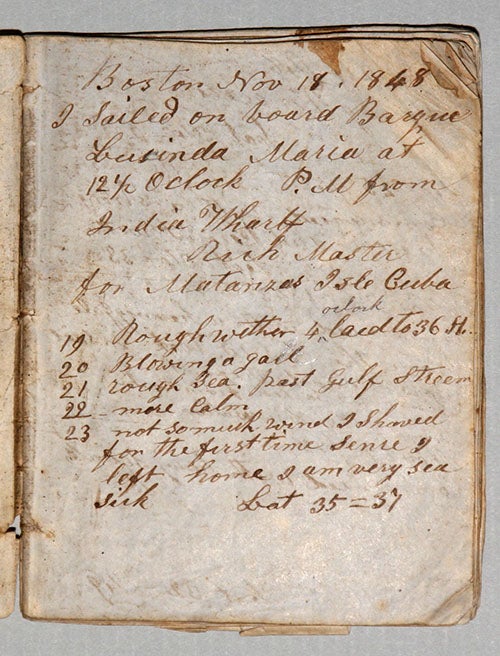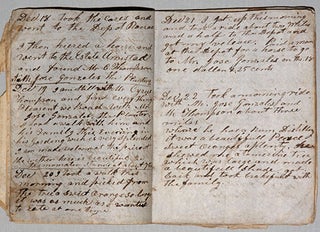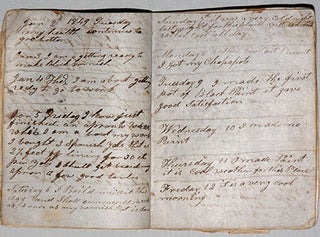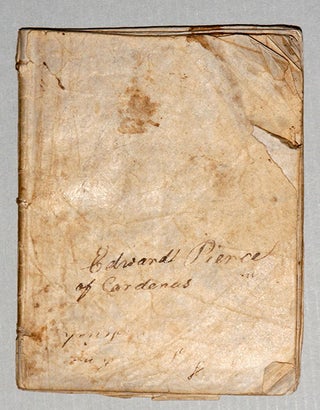Edward Pierce of Cardenas.
24mo [12.6 x 10.1 cm], (48) ff., (19) of which are blank, (2) smaller slips of paper affixed with a stick pin. Unbound, two gatherings sewn together, with outer sheets acting as wrappers. Some soiling and minor tears to wrappers. Only minor spotting and wear to the leaves, handwriting very legible.
Fascinating pocket diary of a Boston paint-maker Edward Pierce, who journeyed to Cuba in the winter of 1848-49 to undertake seasonal work on the island during a period when the possibility of a United States annexation of Cuba was coming to a head in the expeditions of the Venezuelan filibuster General Narciso López (1797-1851). Simply sewn and retaining its paper wrappers, Pierce’s notebook is of the sort that must have been produced in large numbers during the 19th-century, but such fragile documents rarely survive today, least of all examples having seen two sea journeys and four months in tropical climes.
On 18 November 1848, Pierce departed for Matanzas, Cuba, from India Wharf, Boston, aboard the Lucinda Maria. He gives a day-by-day account of his 18-day journey, noting weather conditions, his latitude, provisions, and his health (e.g., 30 November, “We had a very good Thanksgiving Dinner to day and thought of Home often”; 1 December, “I put on my thin Coat for the first time”). Pierce also remarks on stops in the Bahamas, most notably at the lighthouse at Hole-in-the-Wall on the island of Abaco (the famous natural rock-bridge here was only recently destroyed during Hurricane Sandy).
Having arrived at Matanzas on 5 December, Pierce takes several weeks to clear items through customs, explore his surroundings by foot, horse, steamboat, and railroad, and to make acquaintances around Matanzas, Limonar, and Cardenas. He mentions by name many countrymen settled there (Americans in Cuba were common in the years after the 1823 Monroe Doctrine stoked United States ambitions in the region), as well as his meeting at church with the Governor of Matanzas (“a fine man”), and his various encounters with the local planter and rum distiller José F. Gonzalez, whose excellent estate impressed Pierce (“I took a walk this morning and picked from the tree a sweet orange so large it was as much as I wanted to eat at one time”). Pierce records a lunar eclipse one evening in March and on 15 February 1849 recounts the execution on the beach of soldiers said to have taken part in a conspiracy against the government, recording also news of similar purges at Havana and other cities: These executions likely relate to the failed 1848-49 excursions of Narciso López, who, under the aegis of the United States, sought to liberate Cuba from Spanish power.
On 3 January 1849, Pierce reveals the purpose for his journey to Cuba, which was to manufacture black paint for use in the region. He makes notes on acquiring (and failing to acquire) raw materials (“got my sp[iri]t of oil, red lead and brush for making black varnish”; “I got my chapapote”; “I am out of oil”; “I have not my red lead”), his preparation of the paint (“I have just finished an apron to wear while I am about my work”; “I boiled oil this day and shall commence work as soon as my varnish pot is done”; “a negro was sent me to help me make paint by Don F. Jose Gonszales’ brother”; “I made the first pot of black paint, it gave good satisfaction”), and his efforts to find buyers, all the while pining for news from his family in Boston (“I put up some samples of paint to carry to Cardenas & Matanzes”; “I gave the samples out. I went to the post office but found no letter for me”). Having finished his work (“Made the last black paint. I shall send 1 bbl [barrel] to Don Pablo Rodon”), and the temperate season in Cuba having come to an end, on 4 April, Pierce sailed for New York on the Xenophon ($25 passage), arriving on the 18th and staying with a friend. His final diary entry, on 21 April, reads: “I started from Boston in the 8 o’clock train from George C. Stone’s, and arrived the same evening about 7 o’clock and found my Family all well.”
An appendix to the diary records the names of local paint dealers (two of which are written on slips of paper affixed to a leaf with a stick pin), addresses of clients, dates on which Pierce sent letters home to Boston, and accounts of business and personal expenses, including layouts for medicine, bottles of sarsaparilla, and a share in two lottery tickets.
Sold




